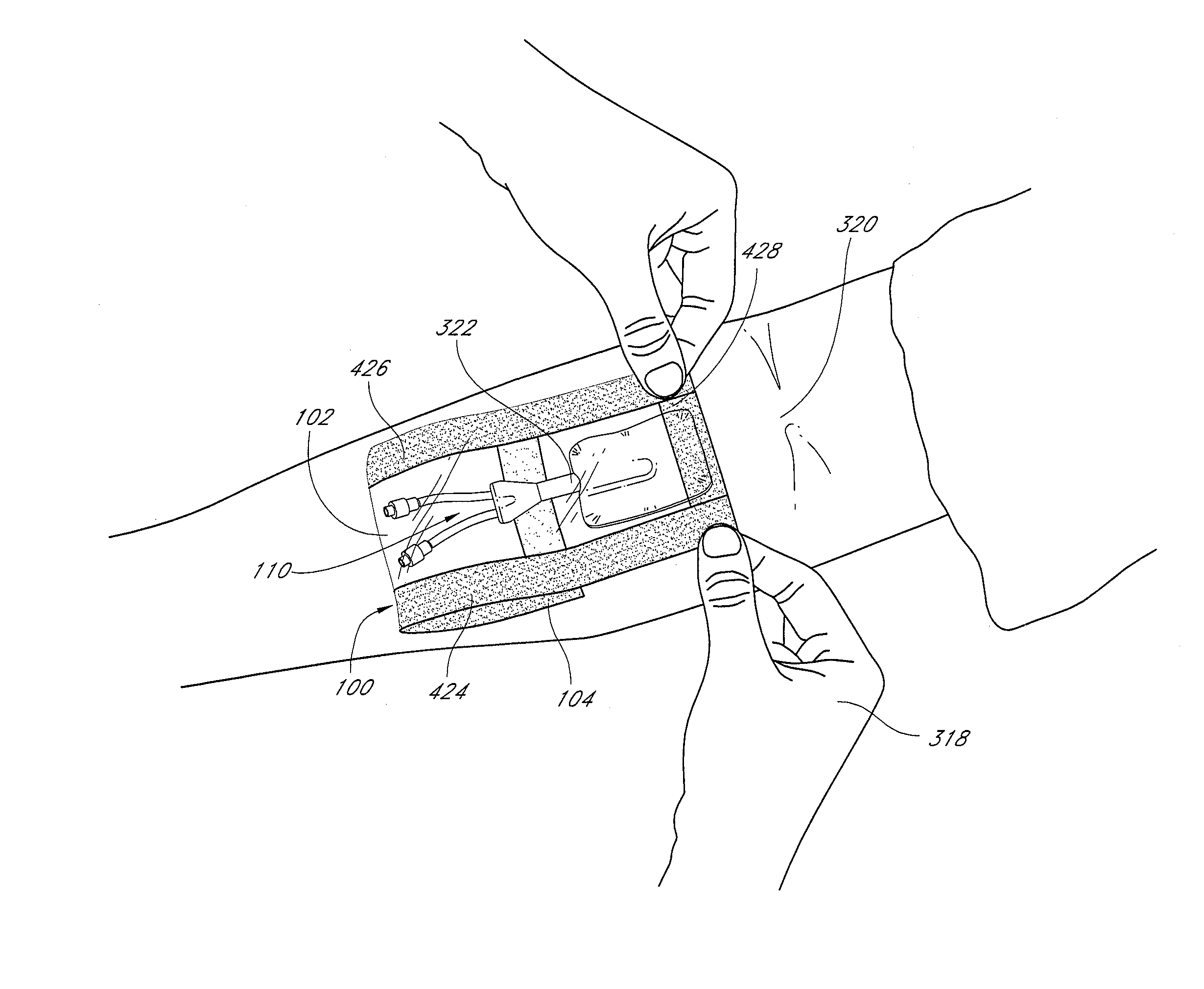[0017]Tabs extending from the edges of the release material assist the user in using the barrier. In some embodiments, these tabs serve to ensure
patient comfort is not compromised by incorrect application. In some embodiments, the
release liner is configured to contain tab portions extending there from in such a manner as to aid the user in properly applying the barrier. To further facilitate these purposes, tabs may be labeled instructing user on how and in what order to remove the release liners. For example, without limitation, tabs may be configured to overlap one another such that it is difficult or impossible to easily remove one tab without first removing another tab. Tabs may also be configured such that removal of one tab automatically begins removal of another tab. In some embodiments, the tabs are labeled with instructions for the user regarding how to remove the liner or release liner and how to apply the underlying adhesive directly or indirectly to a patient's epidermis. Through such labeling or other configuration, the presently disclose medical barrier guides users to remove the tabs in the proper order to obtain the most desirable application and removal properties of a medical
bandage.
[0022]d. Folding the sheet up and over the PICC site or device (forming a protected volume for the PICC extensions,
wound dressing,
wound site or other device) and attaching the inferior edge of the inner adhesive surface to the patient's skin just above the PICC, device,
wound dressing or wound
access site, thus minimizing the required total adhesive contact area with the patient. At this step, a user can fold the un-attached sheet forming a protected volume around the PICC, device,
wound dressing or wound
access site to various degrees, gathering up any slack and pinching together adjacent inner adhesive surfaces before applying to medical barrier to the skin in order to create a seal.
[0025]g. The process allows the user to form a ‘minimum’ contact area on patient's skin, which is desirable for reducing skin reactions to the adhesive as well as limiting discomfort when removed.
[0027]In some embodiments, a portion of a sheet or film upon which adhesive is disposed is accessed and the adhesive is exposed by removing at least a portion of a release liner. The exposed adhesive may then be secured to a patient's body, beneath the
protected area, for example, with the remainder of the device extending downward from the
protected area. Next, another portion or portions of release material may be removed from adhesive disposed upon the other side of the film. Then, the remainder of the device may be folded back over the previously secured adhesive to orientate the exposed adhesive toward the patient's skin. One of ordinary skill in the art will recognize that this forms a pocket volume within the
sheet material between the portions of the sheet upon which adhesive is disposed. Pressing the newly exposed adhesive against the patient's skin will fully enclose and complete the barrier pocket.
[0028]Several benefits may be achieved by application methods such as the embodiments described above: One benefit that can be achieved is that the area of adhesion to the user can be significantly reduced. This can reduce stress on the adhesive contact area when placed on curved surfaces of the body and promotes a durable seal. Some embodiments also provide enhanced freedom to move extremities or other body parts normally while showering without compromising the protective seal of the device. Some embodiments allow the user to form a free moving pouch containing the protected devise (such as PICC or IV lines) particularly at areas of an articulating joint (such as the anti-cubital or
elbow area) where shear stresses on an adhesive placement near or across a joint can compromise the adhesive seal. A further benefit of a smaller surface area of contact between the adhesive and the patient in some embodiments of the methods and devices described is less patient discomfort when removing the medical
protective barrier.
[0029]Some additional benefits that may be provided with the presently disclosed medical barriers involve (i) creating a sealed chamber for surrounding PICC / IV lines, wounds, and access sites that optimize the sealing area, barrier volume, length and width, etc, (ii) creating an effective medical
protective barrier, and (iii) providing a medical
protective barrier having enhanced applicability and
usability features such as enhanced ease of application. Some disclosed embodiments also can allow for the use of a release liner comprised of tabs that further enhances applicability and
usability. Some disclosed embodiments allow for reduced amount of adhesive required to assure an effective
moisture barrier, with can also translate into reduced patient discomfort during removal of a medical barrier. The adhesion area, in some embodiments, comprises a substantially planar contact area between the adhesive and a patient's skin. A further benefit of the disclosed embodiments is the creation of an adjustable-sized protected volume capable of containing a PICC-line or other medical implement. These and other aspects, features and advantages of the present medical barrier will be further understood from a description of certain preferred embodiments illustrated in the attached drawings and described as follows.
 Login to View More
Login to View More  Login to View More
Login to View More 


